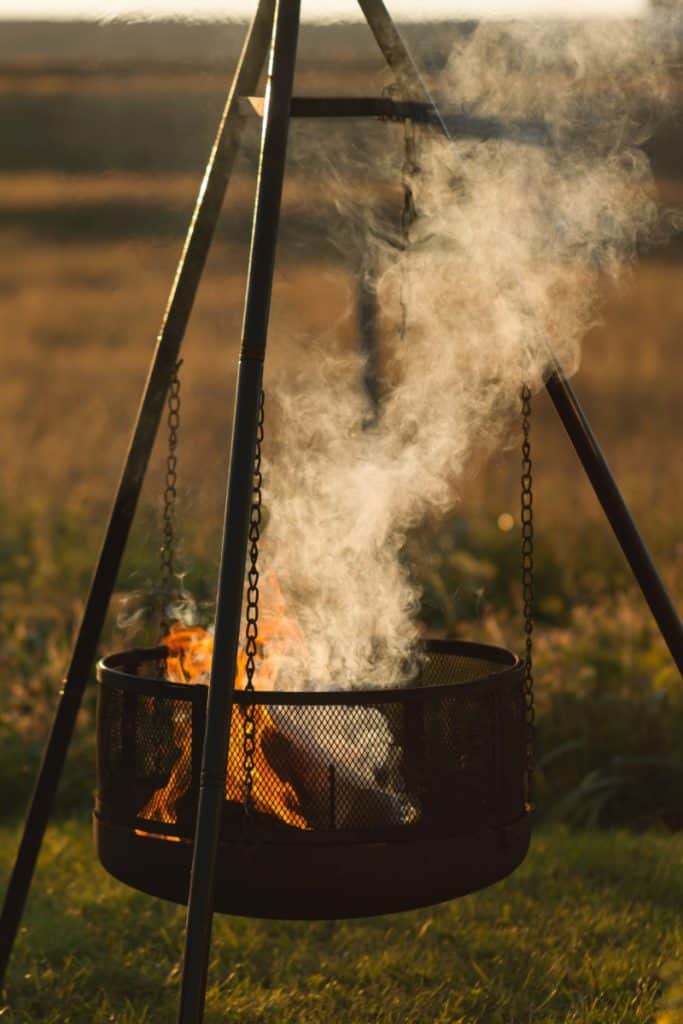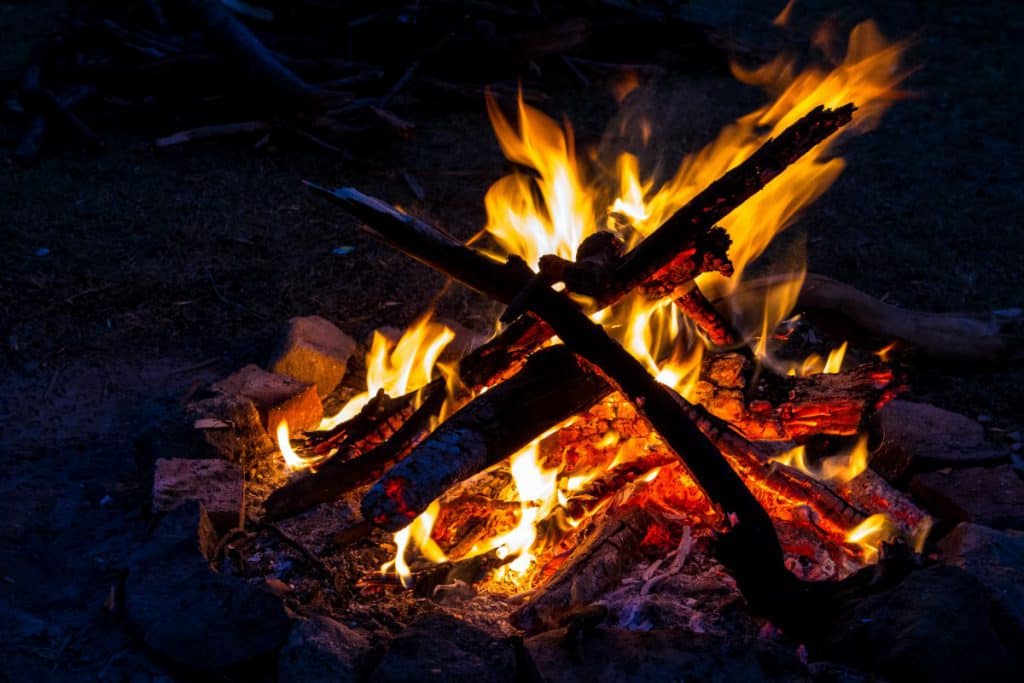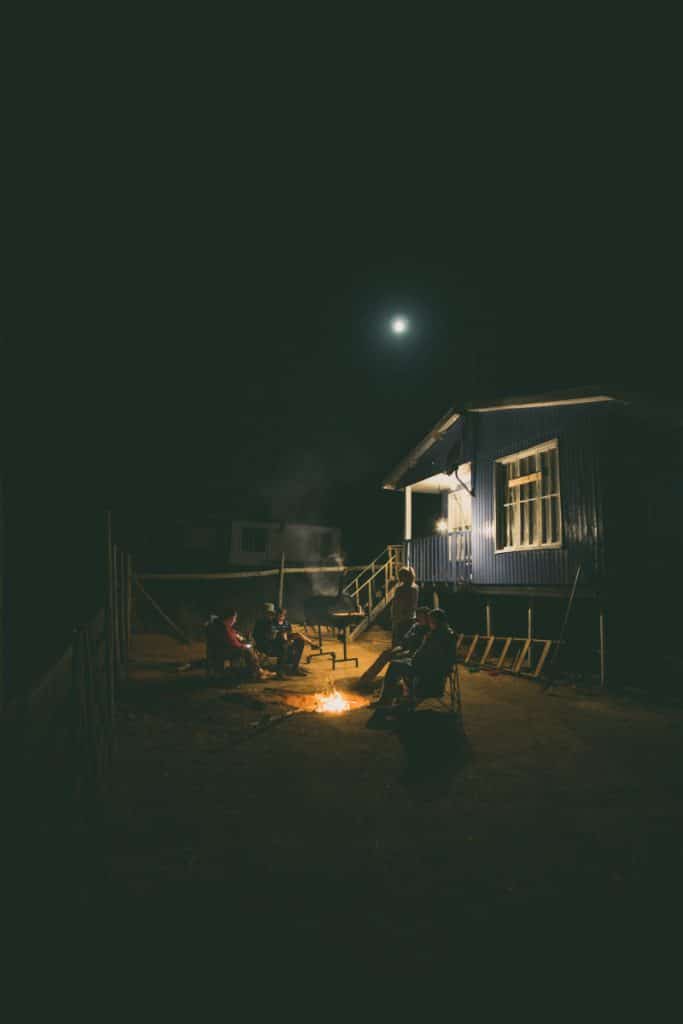There is something about fire that attracts us. It gives us comfort, helps us relax, and for some simply staring into the fire induces a meditative state.
We all love having a fire pit in our garden, it keeps the mosquitoes away, encourages socializing and it probably is the best place to have a barbecue. But a lot of smoke is not what anyone wants, and you probably know that a smoky fire pit makes everyone around it uncomfortable.
Since no one wants that, we need to look into preventing it and into what you can use to have the perfect almost smokeless fire that will also protect the environment.

Do Fire Pits Create a Lot of Smoke? (Things to Know; Steps to Take)
Fire always creates smoke. It’s its giveaway. Remember that at some point in human history, the smoke from fire was used as a means of communication. So, we can say that fire is the Smartphone’s long-lost great, great-grandfather
Smoke signals were used to communicate a lot of important information, but also to gather people. But, right now, when we want to gather people around the fire, we definitely don’t want a lot of smoke.
A well built fire pit, for which you use the proper fuel, shouldn’t create a lot of smoke. If it does, it probably caused by one of the following reasons:
- Insufficient oxygenation of the fuel;
- Improper fuel;
- Residue buildup.
All of these issues are preventable and we are going to show you how to make sure that you will have clean fire that doesn’t smoke too much.
How to Keep a Fire Pit from Smoking
To ensure that your fire pit doesn’t create excessive smoke, you must make sure that it is clean. Even if you always allow everything in the pit to burn completely, there is still aesidue left.
This residue will build up on the walls of the pit, and it will make your fire smoky, even if you burn wood and coal designed for fire pits. The irony is that too much smoke will lead to more residue, which in turn will lead to more smoke.
Make sure to clean your fire pit regularly. The way you can do this depends on the type of fire pit that you own, but the main steps are the same for all pits.
For solid fuel fire pits:
- Remove all the ash and debris;
- Scrub and clean the interior. You must make sure that you pay attention to the manufacturer’s instructions as they differ from product to product. For example, cast iron needs to be cleaned with steel wool, while masonry with a special solution.
- Rinse and dry. This step too depends on the material.
Gas fire pits are definitely easier to maintain, but they still need to be cleaned. Otherwise, there will be incomplete burning of the gas, which will translate into smoke.
To do this you will need to clean the burners according to the manufacturer’s instructions.
Furthermore, make sure that the gas lines are regularly inspected by a specialist, to ensure that the gas flow is OK and that there are no safety concerns.
Another important aspect that is often forgotten is that in order to burn solid fuel, there needs to be a proper air circulation otherwise you will get… yes, you guessed it: smoke.
“Never stack wood and coal too closely together. Make sure that you have a few gaps that will allow the air to flow and the oxygen to fuel your fire.“
The last culprit of a smokey fire is the type of fuel that you are burning.
Ideally, you should only burn wood and coal that was designed for this. Burning yard debris like leaves, or burning household trash like cardboard or cotton will lead to a lot of smoke and sometimes even dangerous fumes.
You probably already noticed that if you burn trash like rubber, there is a huge amount of black smoke. This would affect your fire pit, the ashes that are left will be difficult to clean and fumes that are emanated are extremely dangerous. For this reason in many states it is illegal to burn garbage.
The type of wood that you burn is also important and we are going to discuss it in the next section of our article.

Do Different Types of Wood Make More Smoke?
The type and quality of the wood burned directly influences the amount of smoke that the fire will create.
Dry soft wood is easy to light up, smells rather pleasant and is easy to source. But it also contains resin (the main reason for which it smells so nice), which will release smoke as it burns.
Soft wood, like the one of pine trees, can still be used, but in limited amounts, to get the fire started, but adding too much of it will result in a fast burning fire, and more smoke than what’s worth.
Hard wood is best, like that of oak, maple and fruit trees is best, but there are other particularities that need to be addressed.
In order for the wood to be efficient, meaning to burn for a long time and to create as little smoke as possible, it needs to be dry.
How dry?
Well…ideally at around 15% moisture, but anything under 30% would do.
This means that you should never burn green wood, which would burn fast and leave a thick creosote (a black film) layer on your pit, while also making a lot of smoke.
Good Smokeless Fuels for Your Fire Pit
Good, dry and seasoned wood may be hard to find. You must make sure that your provider is in line with all the regulations and that they can always offer you dry wood.
Another difficult to control aspect is that even if the producer of the wood that you are buying is the same, everything else matters too. Factors like: the distribution chain, storage and the place that sells the wood all have a direct influence on the quality of the final product.
If during transport the wood becomes wet and doesn’t get a chance to dry out, what was once good burning wood has now become wet smokey wood.
The time spent in storage can completely change the particularities of the wood, especially if the space is not well ventilated and the wood develops mold.
Most fire pits are best used with wood, even if coal (even smokeless coal be an option). Wood briquettes are usually great for preventing smoke and to offer a clean fire.
However, the type of fire that we all know and love comes from wood, and in order to obtain a high quality product, you may need to go through some trial and error and to store it yourself, in a dry well ventilated shed.

Steps to Divert Smoke from Fire Pits
Making sure that your fire doesn’t produce too much smoke is one thing, but there are ways of diverting the smoke to not reach the people who gather around the pit.
The best way to do this is to use a smokeless fire pit.
There are different types available. Some of them channel the smoke to another location, while others are able to warm the air around the fire to minimize the smoke output.
The original smokeless fire pit was a simple hole in the ground, connected to an underground tunnel that emerged in a different location. This brought fresh air to the base of the fire, meaning that the fire was more efficient, thus there was less smoke.
Today, many fire pits have technology that mimics this one, but an alternative way to divert the smoke is to learn about your environment and to use it so that any smoke that you may produce, is blown away by the wind, in a direction that doesn’t bother anyone.
What to Burn in a Fire Pit Without Smoke
Having an almost smoke free fire pit is wonderful, but it does take some planning. So, you will need to remember to always have the proper fuel, and to maintain your fire pit to its best form.
You can burn items such as:
- Dry, seasoned wood;
- Wood Bricks and pellets;
- Alternative solid fuel like soy logs or recycled coffee grounds
“No matter what you choose to burn, if the product is designed for fire pits and it’s dry and well stored, it will probably offer you a good fire that produces little smoke.“
Of course, the most important element in a smoke free fire pit is the fire pit itself. As long as you have one that is well built and that was designed to minimize the smoke output, you can rest assured that you will be able to enjoy being outside, next to the fire.
Conclusion
Some fire pits create a lot of smoke, but there are solutions to this problem, and you can read all about them in this article.
Alright, that’s it for this article guys, if you found it useful then a share on social media or your website would be cool!
All the best
Steve
ps here’s a few articles related to this one you might find interesting:
Do Fire Pits Need Air Vents? (Your Model Might!)

